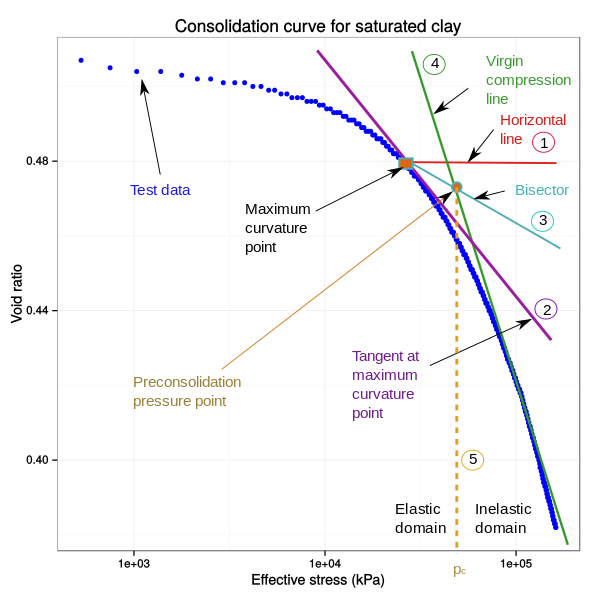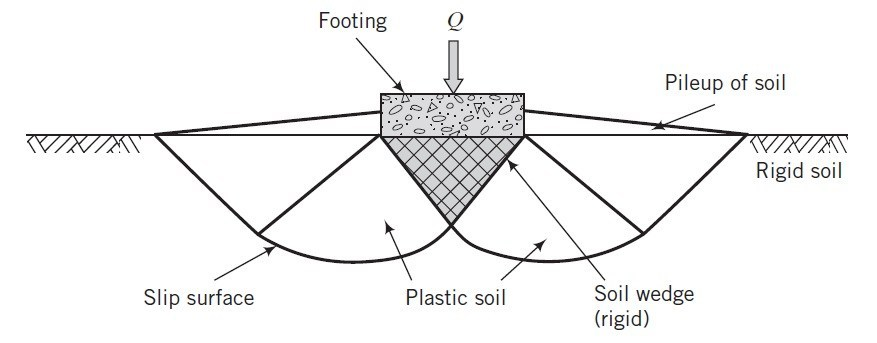In the context of geotechnical engineering, bearing capacity is a reference to the available load-bearing capacity available to support an applied load while staying within specified settlement constraints. Bearing capacity is defined as the pressure which would cause the shear failure of the supporting soil immediately below and adjacent to a foundation. In geotechnical engineering, the property of bearing capacity arises through a combination of the properties of the foundation material (i.e. shear strength of the soil), the geometry and size of the footing as well as the depth of the footing. All these factors need to be considered when assessing for bearing capacity of a foundation.
The bearing capacity of a soil is the maximum average contact pressure between the foundation and the soil which should not produce shear failure in the soil. Ultimate bearing capacity is the theoretical maximum pressure which can be supported without failure. Allowable bearing capacity is the capacity a geotechnical engineer determines to be fit for design purposes for a given foundation. Assessing allowable bearing capacity requires the experience and judgement of a geotechnical engineer (Geotech) and can be complex to determine and is dependent upon the reliability of the available data, among other things. You should never pour concrete for footings without having the foundations inspected by a Geotech.
In certain cases, settlements of the foundation may exceed the maximum allowable design settlement without the foundation undergoing shear failure; in such cases, the allowable bearing capacity is governed by the maximum allowable settlement.
There are three modes of shear failure that govern the limits of bearing capacity: general shear failure, local shear failure, and punching shear failure. These three modes of failure are explored in more detail below.

General Shear failure
The continuous failure surface develops between the edges of the footing and the ground surface. As pressure is increased towards the value “qf” a state of plastic equilibrium is reached initially in the soil around the edges of the footing, which subsequently spreads downwards and outwards. Ultimately, the state of plastic equilibrium is fully developed throughout the soil above the failure surfaces. The heaving of the ground surface occurs on both sides of the footing, although in many cases the final slip movement occurs only one side, accompanied by tilting of the footing, as the footing will not be perfectly level and will hence be biased to fail towards one side. This mode of failure is typical of soils of low compressibility (i.e dense coarse-grained or stiff fine-grained soils), and the pressure-settlement curve is of the general form.
Local shear failure
In this mode of failure, there is significant compression of the soil under the footing and only partial development of the state of plastic equilibrium. The failure surfaces, therefore, do not reach the ground surface and only slight heaving occurs. Tilting of the foundation would not be expected. Local shear failure is associated with soils of high compressibility and is characterised by the occurrence of relatively large settlements (which would be unacceptable in itself) and the fact the ultimate bearing capacity is not clearly defined.

Punching shear failure
Punching shear failure occurs when there is relatively high compression of the soil under the footing, accompanied by shearing in the vertical direction around the edges of the footing. There is no heaving of the ground surface away from the edges, and no tilting of the footing. Relatively large settlements are also a characteristic of this mode, and again the ultimate bearing capacity is not well defined. Punching shear failure will also occur in a soil of low compressibility if the foundation is located at considerable depth. In general, the mode of failure depends on the compressibility of the soil and depth of the foundation relative to its breadth.
